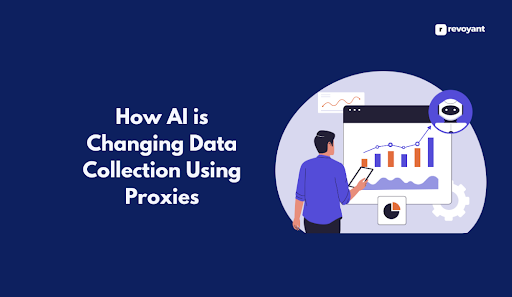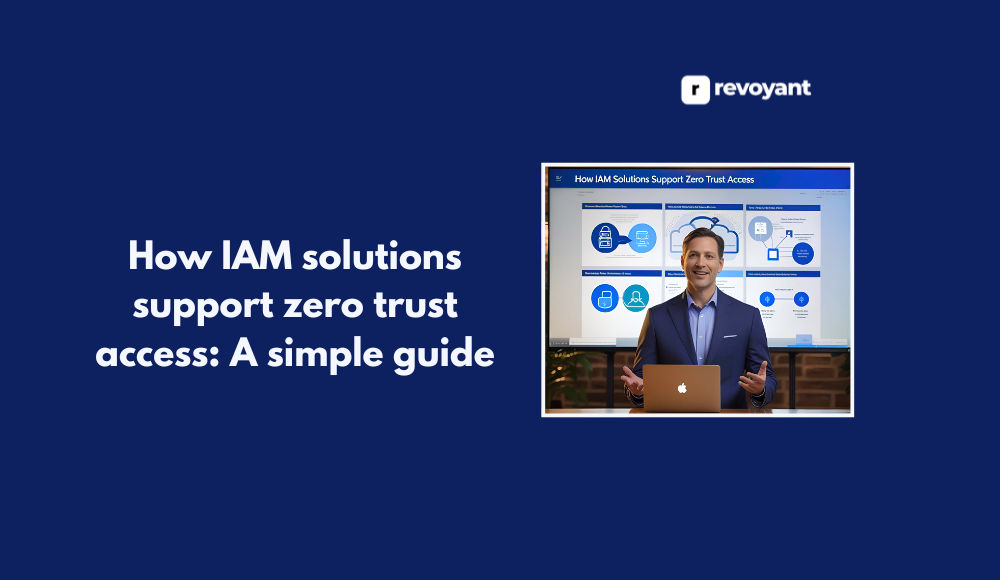⚡ Why This Blog Matters
World‑building can be time‑consuming and detail‑heavy—but Deep Realms uses AI to auto-generate rich, expansive settings with maps, cultures, lore, and narrative hooks in minutes.
🧠 What You’ll Learn Here
Discover how Deep Realms guides you from concept to fully fleshed-out worlds: terrain & climate generation, cultural and political systems, character roles, event triggers, and export options for game design or writing.
🎯 Who Should Read This
Perfect for game masters, novelists, RPG designers, and world‑builders who want to create consistent, immersive fantasy or sci‑fi universes without manual overhead.
If you’re a writer, game designer, or world-builder, you know the thrill of creating entire universes and the challenge of keeping them consistent, detailed, and believable. That’s where Deep Realms comes in. It’s a powerful AI world-building tool designed to help you craft rich, expansive worlds without spending weeks buried in notes or spreadsheets.
In 2025, creative tools are evolving fast. Deep Realms blends intelligent automation with creator control, making it easier than ever to generate lore, maps, characters, and history all in one place. Whether you’re planning your next novel, game, or tabletop campaign, this tool lets you focus on storytelling, not just setup.
Key Takeaways
- Deep Realms is made for creators like writers, game designers, and world-builders who want to bring fictional worlds to life more efficiently.
- It helps save time by using AI to generate rich details like lore, characters, maps, and timelines.
- The tool is designed with modern creative workflows in mind, giving you control while speeding up the process.
- Everything you need is in one place, so you don’t have to jump between documents, spreadsheets, or separate tools.
- It frees you up to focus on the fun part—telling the story—instead of getting stuck in background logistics.
What Is Deep Realms and How Does It Help You Build Worlds with AI?
Deep Realms is an AI-powered world-building platform designed to help creators generate detailed fictional universes with speed and consistency. Whether you’re writing a novel, designing a game, or building a tabletop RPG campaign, it gives you the tools to craft cultures, maps, characters, and storylines without the usual overwhelm.
At its core, Deep Realms combines artificial intelligence with creative structure. You can start from a single idea like a kingdom, a species, or a historic event and the system expands on it, offering context, connections, and supporting details. It doesn’t just generate names or maps; it builds internal logic, history, and relationships that make your world feel alive.
Writers use it to outline epic sagas. Game designers rely on it to map political systems, create side quests, and define character motivations. It’s a creative assistant that helps you stay in flow while maintaining depth and consistency across your entire world.
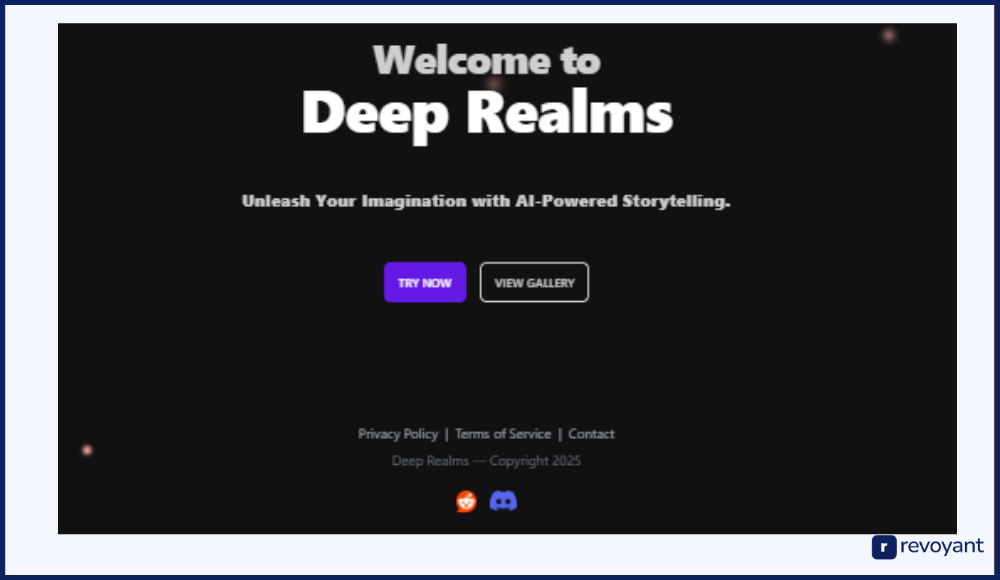
Who Can Benefit from Deep Realms AI World-Building Platform?
Deep Realms is built for creators who work with story-rich worlds. From professional writers and indie game developers to tabletop RPG masters and educators, it supports anyone who needs a deep, consistent universe to power their creative work.
The tool adapts to your workflow whether you’re starting from scratch or adding depth to an existing world—and helps generate content that fits your vision. Below are some of the most common types of users who benefit from Deep Realms.
How Writers and Novelists Use Deep Realms to Build Story Worlds
Deep Realms is a powerful writing companion for authors who want to create vivid, believable worlds for their stories. Whether you’re building a sprawling fantasy empire or a quiet town with hidden secrets, the tool helps develop cultures, character arcs, and historical events that shape your narrative. Writers can use it to outline story beats, generate background lore, or flesh out side characters with meaningful connections.
Instead of getting lost in scattered notes, everything stays organized and consistent across chapters. It also helps beat writer’s block by offering fresh creative prompts based on your world’s logic. The result is a deeper, more immersive reading experience for your audience.
Why Game Designers Use Deep Realms for Lore-Rich Game Worlds
For game developers, Deep Realms simplifies the process of designing complex, interconnected worlds. Whether you’re creating an open-world RPG or a tactical strategy game, the tool helps build factions, political systems, environments, and quest ideas that tie together seamlessly. It’s perfect for planning lore-rich environments without having to manually write every detail.
You can map out region-specific conflicts, design unique characters with motivations, and even simulate historical events that influence gameplay. It saves time in pre-production and helps teams stay aligned with a single source of truth for the game’s universe.
How DMs Use Deep Realms to Design Faster, Deeper RPG Campaigns
Dungeon Masters and RPG creators use Deep Realms to prep campaigns faster and with more depth. Instead of spending hours writing lore or inventing last-minute NPCs, they can generate towns, guilds, and even full quest arcs in minutes. The AI helps you create consistent logic across regions, so the game world evolves naturally with player decisions. Whether you’re running a long-form campaign or need a quick side quest, Deep Realms gives you the structure to build fast without sacrificing quality. It also helps with world continuity across multiple sessions, which players love.
How Screenwriters Use Deep Realms to Craft Immersive Fictional Worlds
Screenwriters use Deep Realms to support world-driven narratives, especially in genres like sci-fi, fantasy, and dystopian fiction. It’s ideal for outlining large-scale settings, political systems, or family dynasties that affect plot and character decisions.
The AI can generate timelines, societal structures, or backstories that spark new scenes and subplots. For visual storytelling, it helps keep world logic tight so audiences stay engaged without confusion. It’s like having a world consultant on call while you focus on writing dialogue and structure.
How Comic and Graphic Novel Creators Use Deep Realms for Consistent Lore
Creators working on comics or graphic novels often have to juggle visual storytelling with dense world-building. Deep Realms helps generate the background structure—locations, histories, and power systems—so the visual side can shine. It’s especially useful for creating consistent character designs and relationships that carry across issues.
Whether you’re creating an underground resistance or a cosmic alliance, the tool helps lay down the groundwork for a believable and compelling universe. This foundation makes writing, drawing, and expanding your world more efficient.
How Educators Use Deep Realms to Build Engaging Learning Worlds
Educators and instructional designers sometimes use world-building to create immersive learning environments—think historical simulations, interactive stories, or educational games. Deep Realms helps generate engaging fictional or semi-fictional contexts for students to explore.
Whether you’re designing a classroom simulation or a choose-your-own-adventure module, the AI can help flesh out characters, rules, and settings. It adds narrative depth that makes learning stick, especially in humanities and creative writing curriculums.
Deep Realms Pricing Plans: Free, Pro, and Studio Tiers Explained
Deep Realms offers flexible pricing plans to fit different creative needs and budgets. Whether you’re just getting started or managing a full production team, there’s a plan that gives you the right mix of features, support, and creative freedom. Here’s a breakdown of what each plan includes and who it’s designed for.
| Plan | Monthly Price | Features |
|---|---|---|
| Free Plan | $0 | Limited world slots, basic AI lore generation, map preview access, character creation cap. Great for testing the platform. |
| Pro Plan | $9/month | Unlimited worlds, advanced AI content generation, full map builder, character and timeline tools, standard export options. |
| Studio Plan | $29/month | All Pro features, plus team collaboration, shared world access, version control, and premium export formats for production workflows. |
Top Features of Deep Realms for Fast, AI-Powered World-Building
Deep Realms is designed to handle the heavy lifting behind fictional world-building, giving creators the freedom to focus on storytelling. Its features are tailored for depth, flexibility, and creative control—helping you design expansive worlds that stay consistent, logical, and full of life.
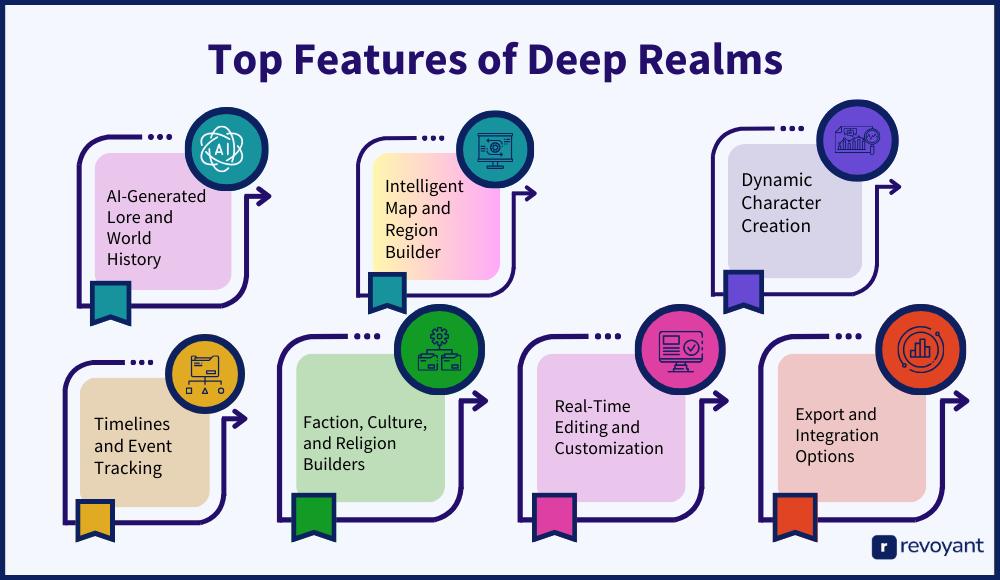
AI-Powered Lore and History Generation That Feels Real
This feature is the heart of Deep Realms. It uses AI to generate complete cultural systems, historic events, legends, and political developments that feel organically tied to your world. Whether you want to create the founding myth of an empire or a timeline of ancient wars, the tool provides context and nuance that make it believable.
Unlike generic name or story generators, this system keeps your lore consistent across different regions and characters. You’re not just creating isolated ideas—you’re building a living, breathing history that influences everything else in your world. And because it’s fully editable, you can reshape it to match your exact tone or genre.
Smart Map Builder for Geography-Driven Storytelling
Maps in Deep Realms are more than visuals—they’re part of the story engine. When you create a location, the tool considers geography, climate, resources, and population dynamics to place it logically within your world. Cities appear near rivers or trade routes, mountain passes become points of conflict, and forests may hide ruins tied to your lore.
You can zoom in or out to work at any scale, from a continent to a single neighborhood. It’s not just about where things are—it’s about why they matter in your narrative. This makes the map builder ideal for both writers and game developers who need their worlds to function as real environments.
Create Deep, AI-Generated Characters with Arcs and Backstories
Characters are built with layers in Deep Realms. The tool generates names, roles, appearance traits, and detailed backstories based on your world’s structure. But it doesn’t stop there—it also includes personal goals, relationship networks, political leanings, and even character arcs that evolve over time. Each character can be tied to events, locations, or factions, giving them context that makes them feel authentic.
You can use it to fill out a main cast or create dozens of NPCs in a campaign, all with meaningful connections. The more you build, the more your character web grows, supporting deeper storytelling and more immersive gameplay.
Build Story Timelines and Track World Events Seamlessly
This feature helps you manage the flow of time in your world. You can add major events like battles, royal successions, technological breakthroughs, or character milestones, and see how they affect the broader world. Events can be linked to specific regions, cultures, or characters, creating a ripple effect that helps maintain logic in your narrative.
It’s ideal for creators working on epics, series, or campaign arcs that require long-term planning. Plus, visual timeline tools make it easier to see the sequence of events at a glance, so you don’t lose track of what happened, when, and why.
Design Factions, Cultures, and Religions That Add World Depth
World-building gets much richer when you dive into the beliefs and power structures of your people. Deep Realms lets you create political factions with defined goals, cultural groups with traditions and values, and religions with rituals, holidays, and origin myths.
These systems are not just flavor—they affect diplomacy, social behavior, and even character motivations. You can map out rivalries, historical tensions, or alliances that add tension and depth to your story. This helps you avoid flat world-building by giving every group its own voice and agenda, which is crucial for immersive storytelling and meaningful conflict.
Real-Time Editing and Customization for Total Creative Control
Every piece of content generated in Deep Realms is open to customization. You can rewrite AI outputs, expand on them, or delete and start fresh—whatever fits your workflow. This makes it a highly flexible tool for both planners and discovery writers.
The real-time aspect means that any change you make to a place, person, or event can automatically sync with connected elements, so you don’t accidentally break continuity. It gives you a reliable workspace to build freely without losing control. Whether you’re outlining or mid-draft, the tool adapts to how you think and write.
Easy Export Options for Writers, RPG Creators, and Game Developers
Once your world is built, it’s easy to bring it into your production pipeline. Deep Realms lets you export your content into formats for writing software like Word or Scrivener, campaign guides for tabletop games, or even narrative design tools for video games.
The exports are structured and easy to navigate, so you’re not stuck copying and pasting or reformatting everything by hand. If you work with a team, shared exports make collaboration smoother and more organized. It helps you take your ideas from planning to production without losing momentum or structure.
Deep Realms Pros and Cons: Is It the Right World-Building Tool for You?
Before choosing any creative tool, it’s helpful to weigh its strengths and limitations. Deep Realms is packed with features that support fast, immersive world-building, but like any platform, it may not fit every workflow out of the box. Here’s a quick look at what it does well and where you might want to consider your needs.
| Pros | Cons |
|---|---|
| ✅ Speeds up world-building with AI-generated lore and tools | ❌ Not all features available in the free plan |
| ✅ Offers deep customization and manual control over generated content | ❌ May have a learning curve for users new to world-building tools |
| ✅ Includes intelligent map building and timeline tracking | ❌ Requires internet connection to access the platform |
| ✅ Ideal for writers, game devs, DMs, and teams alike | ❌ Collaborative tools limited to higher-tier plans |
| ✅ Supports structured exports for game engines and writing software | ❌ Creative output still benefits from user refinement and editing |
How to Start Using Deep Realms for World-Building in 4 Easy Steps
Getting started with Deep Realms is quick and intuitive. Whether you’re building a brand-new fantasy world or fleshing out an idea you’ve had for years, the platform makes it easy to dive in without getting overwhelmed. Here’s a step-by-step look at how to begin your creative journey.
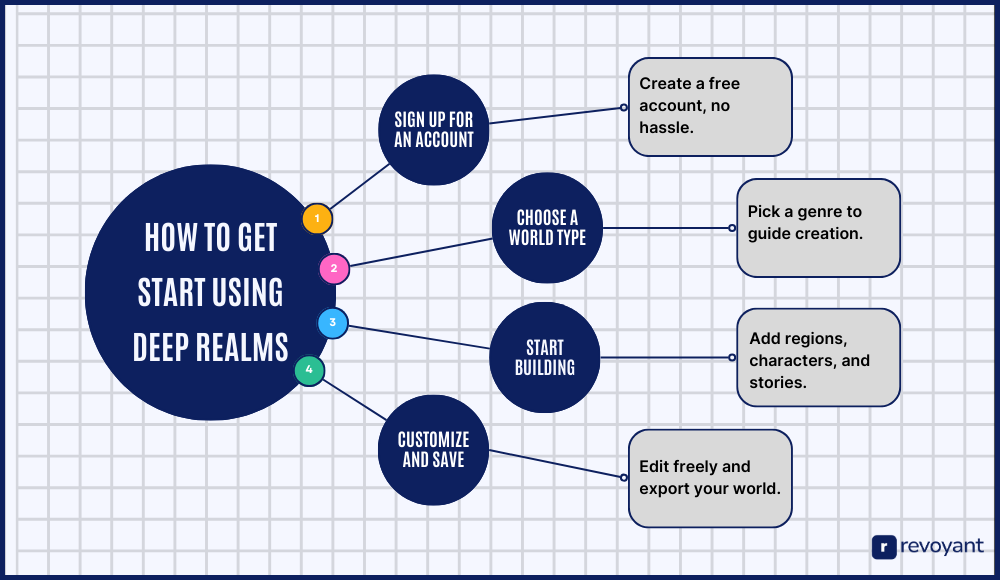
Step 1: Create a Free Deep Realms Account
The first step is creating a free account on the Deep Realms website. The process is simple—just enter your name, email address, and a password. There’s no credit card required to explore the free tier, which gives you access to core features so you can try the tool without pressure.
Once you’re signed in, you’ll land on a clean, distraction-free dashboard that invites you to start your first world. From here, you can choose a theme, explore tutorials, or jump straight into building. The onboarding process is fast, so you’re not stuck reading manuals or watching long videos.
Step 2: Pick a Genre for Tailored World-Building Suggestions
After creating your account, you’ll be asked to choose a world type. This sets the tone and structure for the content Deep Realms will help you generate. The system tailors its AI suggestions to match the genre you select, giving you a more focused creative experience.
- Fantasy: Includes kingdoms, magic systems, creatures, and ancient lore
- Sci-Fi: Focuses on alien civilizations, space travel, and futuristic tech
- Custom: A flexible option for blending genres or building something completely original
This helps shape the way maps, factions, and characters are built, so you start off aligned with your vision.
Step 3: Start Building Regions, Lore, Characters, and More
Once your world type is selected, you can begin adding content. The platform provides intuitive tools to create regions, characters, timelines, and more. You can enter a basic idea—like “a mountain city run by scholars”—and the AI will expand on it with geography, culture, and history.
Everything is interconnected, which means as you add more, the world evolves naturally. You’re free to edit any output or write from scratch if you prefer. The real-time system makes it easy to jump between lore, characters, and events without losing your place.
Step 4: Customize, Save and Export Your World for Any Use
Deep Realms is fully customizable, so you’re never locked into what the AI generates. You can tweak names, adjust historical timelines, flesh out cultures, or completely rewrite any piece of content.
The platform autosaves your work, but you can also manually save versions for different stages of development. When you’re ready to use your world outside the platform, you can export it into documents or campaign guides.
- Save and revisit different versions of your world as it evolves
- Export content for writing tools, game engines, or tabletop sessions
This flexibility means your world is always ready—whether you’re still drafting or ready to publish.
Best Alternatives to Deep Realms for Manual and Modular World-Building
Not every creator builds the same way, and while Deep Realms offers powerful AI-driven tools for fast and structured world-building, some users may prefer different workflows, feature sets, or creative control.
Whether you’re looking for manual world design, collaborative publishing, or modular story tools, there are several strong alternatives worth exploring. Below are some of the top platforms that serve similar purposes, each with its own strengths depending on your creative goals.
World Anvil: Best Manual World-Building Platform for Writers and DMs
World Anvil is one of the most widely used platforms for structured world-building. Designed for writers, dungeon masters, and storytellers, it helps users manually create and organize every aspect of their fictional world using templates, timelines, and interactive tools.
Unlike AI-powered platforms like Deep Realms, World Anvil focuses on detailed manual input, which gives creators full control over how their lore, maps, characters, and events are built. Its wiki-style system is excellent for long-term projects or campaigns that require ongoing reference and collaboration. While it may take time to learn the platform, once you’re familiar with it, World Anvil becomes a powerful creative database and publishing hub.
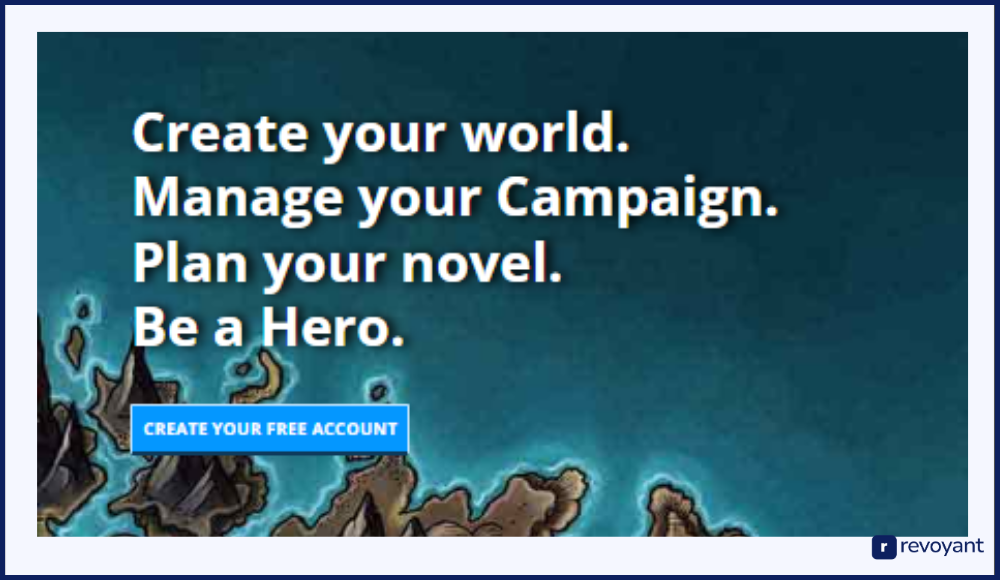
World Anvil Pricing
World Anvil offers multiple plans depending on your needs:
- Free plan with limited features, ads, and capped storage
- Guild tiers starting around $5/month, unlocking more features and privacy options
- Co-authoring, private worlds, and higher asset limits available at mid-to-high tiers
- Lifetime plans available for users who want a one-time payment option
- Discounted yearly subscriptions with access to exclusive community tools and templates
Key Features of World Anvil
What makes World Anvil a strong world-building platform:
- Offers structured templates for almost every creative category—characters, locations, species, items, and more—helping you build with consistency across your entire world
- Includes interactive maps that let you pin locations, connect them to entries, and create a visual index of your world’s geography
- Robust timeline tools allow you to create parallel historical arcs, political timelines, or event threads across cultures or characters
- Lets you control visibility with public/private world settings, perfect for managing campaigns or preparing published content
- Built-in community engagement tools like world challenges, featured creator highlights, and forums keep you connected and inspired
Deep Realms vs World Anvil
Deep Realms and World Anvil both support serious world-builders, but their core focus is different. Deep Realms is optimized for creators who want speed and inspiration through AI assistance, while World Anvil is ideal for builders who prefer full manual control and detailed structure. Below is a side-by-side breakdown.
| Feature | Deep Realms | World Anvil |
|---|---|---|
| AI-Generated Content | Yes – automated lore, maps, and characters | No – all content is manually created |
| Content Structure and Templates | Moderate – AI-first with editable fields | Extensive – dozens of detailed templates |
| Map Integration | Smart map builder with logical geography | Interactive maps with manual linking |
| Timeline and Event Tools | Visual timelines with auto-linking | Manual timelines with custom layering |
| Ideal For | Fast, AI-assisted creative building | Detailed manual world-building and archiving |
| Collaboration and Sharing | Team access on higher tiers | Co-authors, private/public control on mid/high tiers |
| Ease of Use | Quick start with guided AI workflow | Steeper learning curve, high control |
Campfire: Visual World-Building and Writing Tool with Modular Pricing
Campfire is a modular writing and world-building platform designed for authors, screenwriters, and game creators who need flexible tools to organize their stories. It offers a clean, visual workspace where users can build characters, plots, timelines, and worlds, all in one interface. What makes Campfire unique is its “buy only what you need” model—meaning you only pay for the features you actually use.
This makes it a great fit for creators who want structure without being overwhelmed by unused tools. Unlike Deep Realms, it doesn’t generate AI content, but it gives you tight creative control, making it ideal for planners and visual thinkers who want a highly customizable storytelling environment.
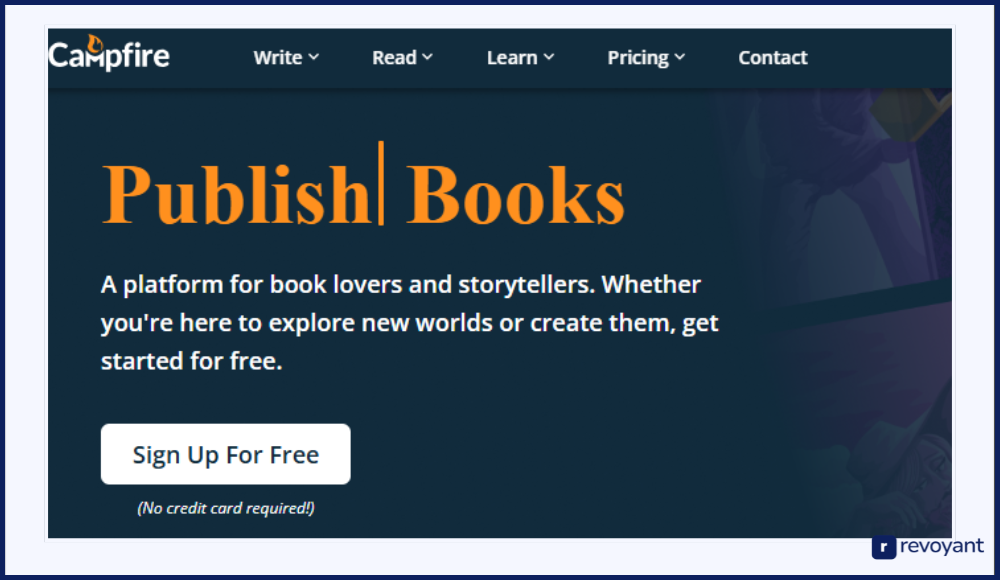
Campfire Pricing
Campfire uses a modular pricing system:
- Free tier available with limited features and storage
- Core modules (Characters, Timeline, Maps, etc.) available individually, usually starting at $1/month per module
- Bundle pricing available for full feature access (around $15–20/month)
- One-time purchase options available for offline desktop versions
- Discounts for students and educational use
Key Features of Campfire
Campfire stands out for its flexibility and visual planning tools:
- Lets users choose and pay for only the tools they need, such as character arcs, timelines, relationship charts, and map creation
- Offers a visual timeline builder that makes it easy to track multiple plot threads, character events, and historical developments across time
- Relationship webs help you visualize how characters are connected and how those dynamics evolve throughout your story
- Location and culture modules allow for deep world-building without forcing a specific structure, supporting original and genre-blended projects
- Cloud-based platform with offline options for writers who prefer to work without internet access
Deep Realms vs Campfire
Deep Realms and Campfire both support structured storytelling, but with very different approaches. Deep Realms offers speed and inspiration through AI generation, while Campfire focuses on giving you complete manual control with a modular setup. Here’s how they compare.
| Feature | Deep Realms | Campfire |
|---|---|---|
| AI-Generated Content | Yes – lore, maps, timelines, and characters | No – all content is manually created |
| Modular Feature Access | No – all tools included by tier | Yes – pay only for the tools you use |
| Timeline and Plot Tools | Auto-linked, AI-assisted timeline builder | Visual timeline with full manual control |
| Visual Tools | Smart map builder, character linking | Relationship webs, plot boards, map modules |
| Ideal For | Fast, guided world-building with AI | Manual planning with visual flexibility |
| Offline Access | Web-based only | Available with desktop version |
| Learning Curve | Low – AI helps fill gaps and spark ideas | Moderate – more setup, but total control |
Notion: Flexible DIY World-Building for Organizers and Planners
Notion is an all-in-one productivity platform that many creators use for planning, note-taking, and organizing large creative projects. While it isn’t built specifically for world-building, its flexibility makes it a solid option for writers and game designers who like to build their own systems from scratch.
Notion allows you to create interconnected pages, databases, and templates for characters, timelines, maps, or plot structures. It doesn’t generate content for you, but it gives you a clean, distraction-free space to design your worlds however you want. For creators who value customization and control over automation, Notion can be a powerful tool.
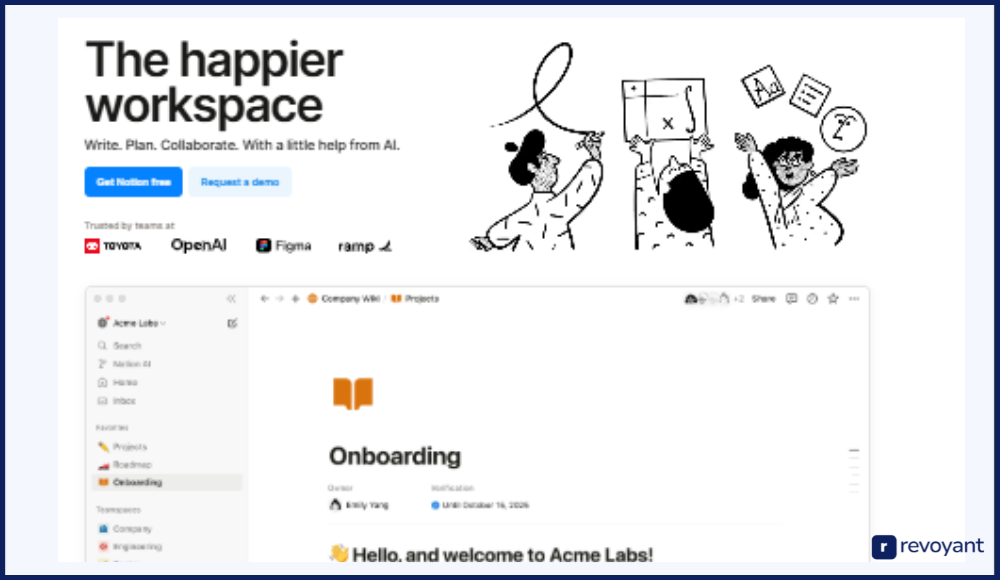
Notion Pricing
Notion offers flexible plans for individuals and teams:
- Free for personal use with unlimited pages and blocks
- $8/month for the Plus plan with file uploads, version history, and advanced sharing
- $15/month for the Business plan with collaborative tools and admin controls
- Enterprise pricing available for larger teams and organizations
- AI features (optional) available at additional cost but not necessary for world-building use
Key Features of Notion
Here’s why some world-builders use Notion despite it not being purpose-built for storytelling:
- Allows full control over your layout and system design, using linked pages, databases, and toggle blocks to organize lore, characters, and events
- Templates can be created from scratch or imported from the Notion community to match the needs of your genre or storytelling structure
- Offers tagging, filtering, and views (like boards or tables) to help manage timelines, relationships, or chapter outlines
- Works seamlessly across desktop and mobile, making it easy to update your world from anywhere
- Great for long-form projects where you want a personal wiki or private knowledge base without constraints
Deep Realms vs Notion
Deep Realms vs Notion represent two very different philosophies. Deep Realms is a specialized AI tool built for fast, guided world-building, while Notion is a blank canvas for those who prefer manual systems and total flexibility.
| Feature | Deep Realms | Notion |
|---|---|---|
| AI-Generated Content | Yes – built-in world-building automation | No – all content is written manually |
| World-Building Tools | Yes – maps, lore engines, timelines, factions | No – requires custom templates |
| Structure and Organization | Guided and auto-linked by design | Fully manual – user defines structure |
| Customization | Moderate – editable but based on built-in tools | High – fully custom, modular setup |
| Ideal For | Fast, AI-assisted world creation | Creators who want total control over layout and content |
| Collaboration and Sharing | Team access with export options | Live editing, sharing links, team workspaces |
| Learning Curve | Low – plug and play | Moderate – setup needed before it becomes efficient |
LegendKeeper: Lore-Rich Map-Based World-Building for GMs and Writers
LegendKeeper is a powerful world-building and campaign management tool designed with game masters and storytellers in mind. It’s built around a clean, map-first interface that lets you create rich, interconnected lore anchored directly to locations. Ideal for tabletop RPGs and story-driven games, LegendKeeper helps you organize your world’s geography, characters, history, and factions all in one place.
Unlike Deep Realms, it doesn’t use AI to generate content, but it excels in keeping everything tightly linked and easy to reference during gameplay or writing. For creators who value precision, privacy, and organization, LegendKeeper is a focused, purpose-built tool that’s made to scale with your world.
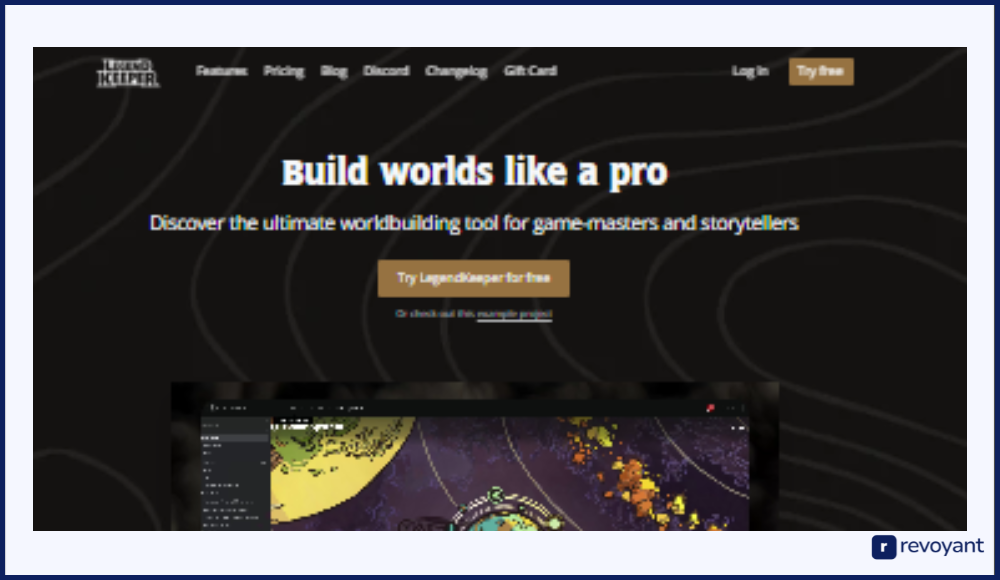
LegendKeeper Pricing
LegendKeeper offers simple, clear pricing:
- $9.99/month for full access to all features
- $99/year for an annual subscription (save ~17%)
- 14-day free trial available to test all features
- No separate pricing tiers — all users get the same functionality
- Designed for individual creators and small teams
Key Features of LegendKeeper
LegendKeeper is built to support immersive, organized world-building:
- Interactive map system lets you pin articles to locations, link them across your world, and navigate lore visually in real time
- Article linking system allows deep interconnectivity between characters, places, events, and concepts for better consistency
- Campaign mode lets GMs share a player-facing version of the world with limited access, keeping secrets hidden while enhancing immersion
- Timeline feature allows basic chronological tracking of key events, supporting session prep and story progression
- Offline-first performance, fast loading, and clean UI make it a practical tool for both creative planning and live session reference
Deep Realms vs LegendKeeper: AI Automation vs Map-First Manual Tools
Deep Realms and LegendKeeper both focus on supporting structured world-building, but their core strengths are different. Deep Realms helps creators generate content through AI, while LegendKeeper is all about organizing handcrafted worlds with precision and clarity.
| Feature | Deep Realms | LegendKeeper |
|---|---|---|
| AI-Generated Content | Yes – lore, characters, maps, factions | No – all content is manually created |
| Map Tools | AI-generated maps with logic and geography | Interactive pin-based maps with manual entry |
| Article and Lore Management | AI-generated, auto-linked content | Manual articles with deep interlinking |
| Player View/Collaboration | Team features on higher tiers | Campaign mode with player-facing content |
| Ideal For | Creators who want fast, guided content generation | GMs and writers who want to handcraft and organize a world visually |
| Offline Support | Online-only platform | Built for speed with offline-first performance |
| Learning Curve | Low – easy start with AI assistance | Moderate – best for structured thinkers who like manual input |
Scrivener: Best Tool for Long-Form Writers Organizing Large Projects
Scrivener is a writing and project management tool popular among novelists, screenwriters, and long-form storytellers. While not a traditional world-building platform, it offers powerful organization features that make it ideal for managing large, complex writing projects. You can break your story into scenes, chapters, or categories, and keep research, character notes, and world lore in one unified space.
Scrivener doesn’t generate content for you, and it doesn’t include map-building or faction tools, but it excels at keeping your writing process organized. For authors who already have their world in mind and just need a structured way to build and write, Scrivener remains a go-to option.
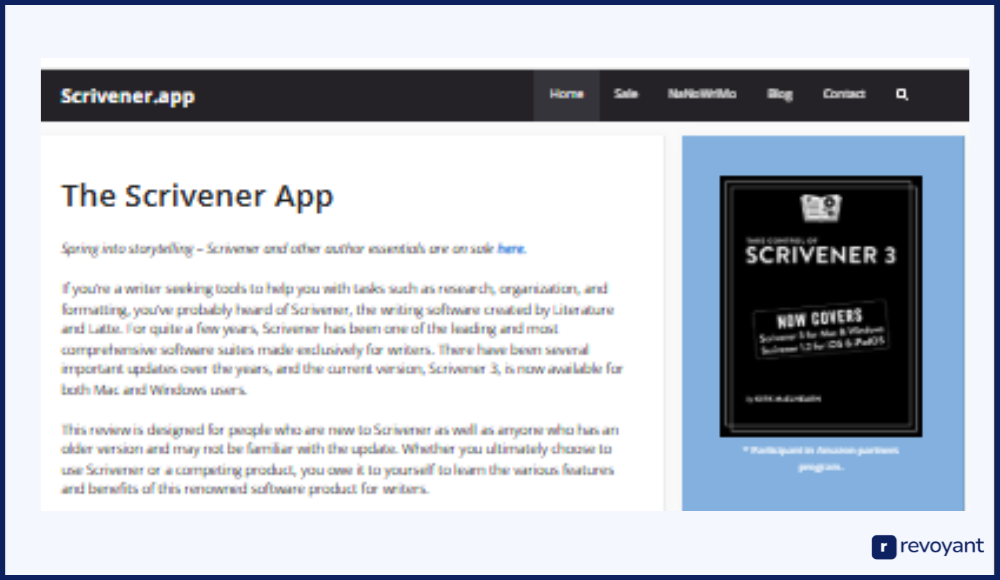
Scrivener Pricing
Scrivener uses a one-time purchase model:
- $59.99 one-time license for macOS or Windows
- $23.99 for iOS version (sold separately)
- No monthly subscription required
- Free trial available for 30 days of actual use (not consecutive days)
- Family or education discounts available on request
Key Features of Scrivener
Scrivener focuses on writing structure and project management:
- Binder system lets you break your work into parts (scenes, chapters, locations) and easily rearrange them as your story evolves
- Corkboard view allows you to visually outline your story with movable index cards, perfect for plotting or planning arcs
- Split-screen mode lets you view your manuscript alongside notes, character sheets, or research as you write
- Research folder keeps your world-building documents, images, and references all in one place, easily accessible during drafting
- Compile feature exports your project in various formats (PDF, Word, ePub), streamlining the publishing process for books and screenplays
Deep Realms vs Scrivener: World Builder vs Writing Workspace
Scrivener and Deep Realms serve very different needs. Deep Realms helps build the world itself with AI support, while Scrivener is built for the writing and editing phase—once your world already exists. Here’s how they compare:
| Feature | Deep Realms | Scrivener |
|---|---|---|
| AI-Generated Content | Yes – world lore, timelines, characters | No – user writes everything manually |
| World-Building Tools | Built-in systems for maps, factions, events | No – organizational only, no world logic |
| Writing Environment | Limited to notes and exports | Full-featured long-form writing tool |
| Visual Organization | Smart map and character connections | Binder, corkboard, and split-screen views |
| Ideal For | Creators building and expanding fictional worlds | Authors writing full manuscripts with complex structure |
| Pricing Model | Subscription-based | One-time purchase, no ongoing fees |
| Offline Access | Requires internet | Fully offline, local project storage |
Deep Realms vs Other Tools: Feature-by-Feature Comparison for Creators
Choosing the right world-building tool depends on your creative style, technical needs, and how much automation you want.
The table below compares Deep Realms with five popular alternatives to help you quickly evaluate which platform best fits your workflow. This side-by-side view focuses on core features like content generation, organization, flexibility, and usability.
| Tool | AI-Generated Content | Best For | Customization Level | Pricing |
|---|---|---|---|---|
| Deep Realms | ✅ | Fast, structured world-building with AI assistance | Moderate – editable outputs | – Free Plan (basic tools) – $9/month (Pro) – $29/month (Studio) |
| World Anvil | ❌ | Manual world-building and campaign prep | High – deep templates and structure | – Free Plan – Guild tiers from ~$5/month – Lifetime plan available |
| Campfire | ❌ | Visual planners, timeline creators | High – choose your own modules | – $1–$5/module – ~$15–$20/month bundle – One-time desktop option |
| Notion | ❌ | Flexible DIY organization | Very High – fully custom layouts | – Free Plan – $8+/month for premium – Optional AI add-on ($10–$15) |
| LegendKeeper | ❌ | GMs and writers managing structured lore | High – map-first content organization | – $9.99/month – $99/year – 14-day free trial |
| Scrivener | ❌ | Long-form writers and manuscript organization | Medium – writing-first structure | – One-time: $59.99 (Mac/Windows) – $23.99 (iOS) – 30-day free trial |
Why Choose Deep Realms: AI World-Building That Saves Time and Sparks Ideas
With so many creative tools available, it’s important to find one that doesn’t just store your ideas—but actually helps you develop them.
Deep Realms stands out for its ability to accelerate the world-building process while keeping your vision at the center. Here’s why it’s a smart choice for storytellers, game designers, and world-builders who want both speed and structure.
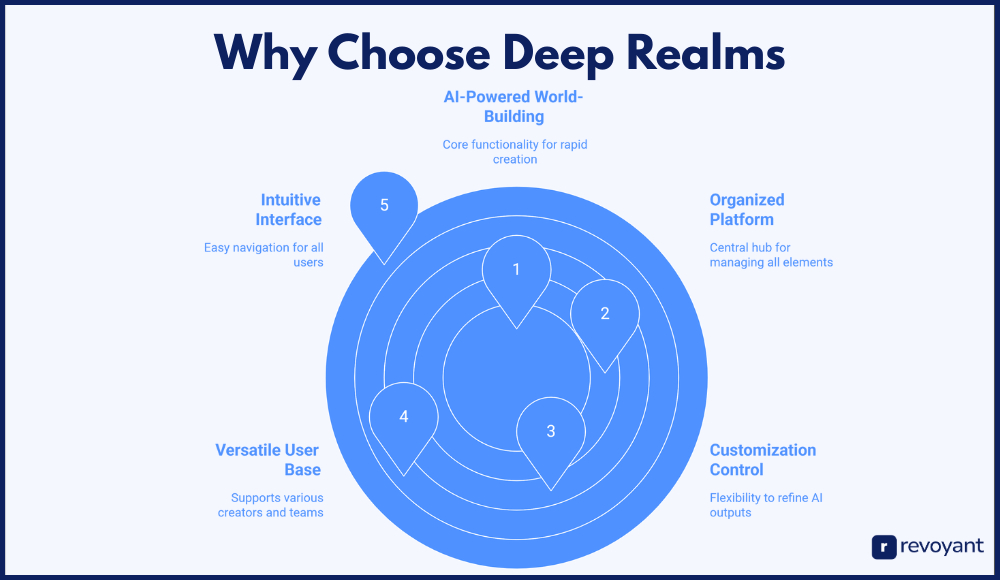
Built Story Worlds Fast Without Losing Depth or Logic
Deep Realms uses AI to help you create lore, characters, factions, and regions in a matter of minutes—not hours or days. But this speed doesn’t come at the cost of quality. The content generated is logically connected, richly detailed, and designed to evolve as your world expands.
Whether you’re building a single village or an entire galaxy, Deep Realms gives you deep, consistent output without the creative burnout that often comes with manual world-building. It keeps your imagination flowing instead of slowing you down. The platform supports spontaneity without sacrificing structure.
Manage All Your World-Building in One Organized Platform
Instead of bouncing between notes apps, spreadsheets, and map tools, Deep Realms keeps everything in one place. You can build regions, timelines, cultures, and character profiles—and they all connect automatically.
This creates a seamless, intuitive workflow that helps you stay focused and organized. It’s especially useful for long-term projects or serialized storytelling where continuity matters. The built-in linking system means you can explore your world naturally, without backtracking. Your ideas stay clear, accessible, and creatively connected.
Deep Realms Gives You Control to Refine and Customize AI Outputs
While the AI gets you started fast, you’re never locked into the output. Every piece of content can be rewritten, expanded, or reorganized to match your tone, genre, or storytelling needs. This makes Deep Realms equally useful for planners and discovery writers.
Whether you want to dive into customization or let the AI guide you, the platform adjusts to how you like to work. It respects your creative process, giving you structure without restrictions. You’re in control from the first word to the final export.
Who Deep Realms Is Built For: Writers, Game Devs, DMs, and Teams
Deep Realms isn’t just for one type of creator. Writers use it to shape entire story worlds. Game developers use it to design factions and backstory systems.
Dungeon Masters use it to generate quests, characters, and political conflicts in minutes. No matter what kind of world you’re building, the platform is flexible enough to support your creative goals. Whether you’re writing solo or running a team-based game, it scales with you. It’s a tool designed to support storytelling in all its forms.
Simple, Intuitive Interface for First-Time World-Builders
You don’t need to be tech-savvy to use Deep Realms. The interface is clean, modern, and easy to navigate—even if it’s your first time using a world-building tool.
Helpful prompts guide you through the process, and the tool’s structure makes it easy to see how different elements of your world connect. You can go from blank page to living, breathing world faster than you’d expect. It’s a no-fuss, no-clutter creative experience. You’ll spend more time creating and less time figuring things out.
Choose a Plan That Matches Your Creative Workflow
Deep Realms offers a free tier for creators who want to explore the platform before committing. As your project grows, you can upgrade to Pro or Studio plans to unlock unlimited content generation, team collaboration, and export features. There’s no pressure to pay upfront, and every tier includes access to core creative tools. It’s a flexible model that works for both hobbyists and professionals. You only pay for what you need, when you need it. That makes Deep Realms accessible and sustainable for all creators.
Final Thoughts: Is Deep Realms the Best World-Building Tool for You?
World-building is one of the most rewarding parts of storytelling—but it can also be time-consuming. Whether you’re crafting a fantasy epic, building a TTRPG campaign, or developing lore for a game, the right tool can make your process faster and more enjoyable. Deep Realms combines creative freedom with AI-powered speed to help you generate and organize content without the usual overwhelm.
While alternatives like World Anvil, Campfire, Notion, LegendKeeper, and Scrivener have their strengths, Deep Realms offers a focused, AI-driven approach for creators who want to build smarter, not slower.
Deep Realms FAQs: Answers for Writers, Game Designers, and Educators
Is Deep Realms only for fantasy writers?
Not at all. While it works great for fantasy, Deep Realms supports multiple genres including sci-fi, dystopian, steampunk, and custom world types. You can build anything from ancient kingdoms to futuristic colonies.
How is Deep Realms different from tools like World Anvil or Campfire?
Deep Realms stands out by using AI to help generate lore, characters, maps, and more—so you’re not starting from scratch. Other tools are more manual and focus heavily on structure. Deep Realms offers speed, consistency, and creativity in one package.
Can I edit the content that Deep Realms generates?
Yes. Everything generated is fully editable. You can rewrite, expand, or delete any part of your world, so the final output always reflects your voice and story goals.
Is Deep Realms good for game design and tabletop campaigns?
Definitely. Game designers and DMs use Deep Realms to generate settings, NPCs, quests, and world logic quickly. It’s especially helpful for prepping campaigns or prototyping game lore in less time.
Does Deep Realms offer a free version?
Yes. There’s a free plan available that lets you explore the platform and try its core features. When you’re ready for more, you can upgrade to Pro or Studio tiers based on your needs.




